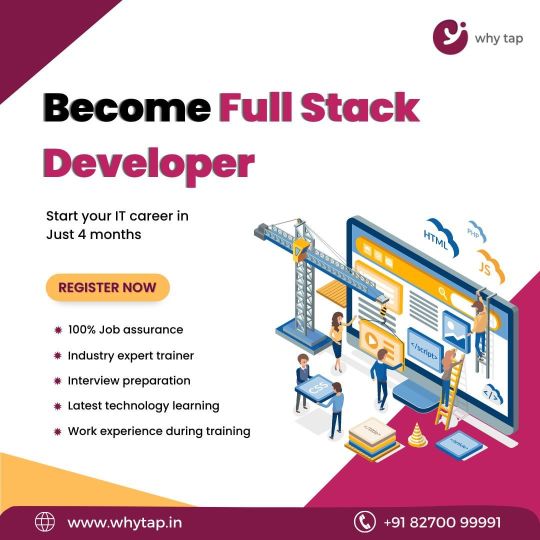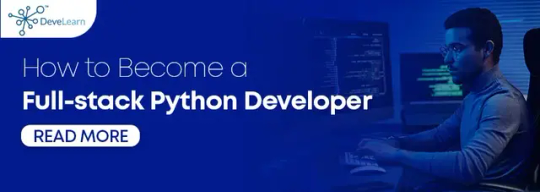#full stack coding course
Link
#Mean Stack Course#python online tutorial#MERN Stack Course#joomla classes#full stack coding course#best course to get job#php training institute#best it courses#it classes#web development training
0 notes
Text
#code#full s#full stack course#full stack training#full stack web development#full stack developer#course#training#curse in pune
2 notes
·
View notes
Text
Unlock the Power of Java Programming
Java, renowned for its versatility and widespread use, is a programming language that empowers developers to build a wide range of applications. If you're looking to master Java programming and enhance your career prospects, Technolearn Training Institute in Pune offers comprehensive Java Classes in Katraj that can help you achieve your goals.
The Java classes in Katraj at Technolearn Training Institute cover all the essential concepts and techniques needed to become a proficient Java developer. From the fundamentals of Java programming to advanced topics like object-oriented programming, multithreading, exception handling, and database connectivity, the course curriculum is designed to provide a solid foundation in Java development.
Led by industry-experienced instructors, the Java Classes in Katraj at Technolearn Training Institute ensure a holistic learning experience. Through a combination of theory sessions, practical exercises, coding assignments, and real-world projects, students gain hands-on experience and develop the necessary skills to tackle Java programming challenges.
Technolearn Training Institute is equipped with state-of-the-art facilities, including well-equipped computer labs with the latest software and tools. The institute also provides access to a vast library of reference materials and resources, enabling students to explore and deepen their understanding of Java programming.
Upon successful completion of the Java Classes in Katraj, students acquire comprehensive knowledge of Java programming and gain the confidence to build robust and scalable applications. They also receive a certificate that validates their skills and enhances their employability in the competitive job market.
Technolearn Training Institute also offers placement assistance to its students. The institute has established connections with leading companies and industry professionals, opening doors to various career opportunities and internships in reputable organizations.
Enrolling in Java Classes in Katraj at Technolearn Training Institute is a stepping stone towards becoming a skilled Java developer. Expand your programming expertise, stay ahead in the ever-evolving software industry, and unlock a world of possibilities with Java programming.
https://www.technolearn.in/java-classes-in-sinhagad-road-anandnagar-pune.html
#pune#offlineclasses#onlineclasses#python#coding#full stack engineer#fullstackdevelopment#software#software testing#softwaretesters#java coding#java course#javascript#java software development#javaprogramming#java development company#coder#developer#html
2 notes
·
View notes
Text

Register Now
#full stack developer#full stack course#job hiring#training#placement#internship#interview#latest technology#technology#webdevelopment#programming#coding#angularjs#technews#computing
6 notes
·
View notes
Text

#programming#success#software#data analytics#datascience#data analysis#full stack course#python#java developers#java#javaprogramming#coding#java full stack developer#java full stack training in pune
0 notes
Text

Full Stack Training In Electronic City Bangalore
🌟 Supercharge your career with Full Stack Training at eMexo Technologies in Electronic City Bangalore! 💼 Don't miss our exclusive offer: Save 30% on course fees for a limited time! Secure your spot today and embark on your journey to becoming a Full Stack expert!🚀
Course details: https://www.emexotechnologies.com/courses/full-stack-certification-training-course/
🌟 Why Choose eMexo Technologies?
Expert Trainers🧑💻
Comprehensive Courses📚
Hands-On Learning💻
Flexible Learning Options💡
Cutting-Edge Curriculum🛠️
Real-time projects✨
Affordable Pricing🚀
For more info👇
📞 +91 9513216462
🌐 https://www.emexotechnologies.com
#full stack training#full stack course#full stack developer#java full stack training in hyderabad#python training#tech education#education#itcourse#it training institute#learning#careerdevelopment#career growth#technologies#software development#coding#learn to code
0 notes
Text
Java Full Stack Developer Classes In Pune | 100% Placement.
Giri's TechHub is most like Classes In Pune for java full stack developer, we provide IT Courses In Pune With 100% Placement Support, Call for Details : +91 9175444433.
#full stack developer#full stack java developer course#it training courses#IT classes in pune#java clsses in pune#Java full stack developer#C#C++#Java#java developers#technology#software#javascript#java development company#developer#java course#coding
0 notes
Text
Full stack development covers both the front end (client side) and back end (server side) of web applications. In the early days, web development was limited to static HTML pages. The LAMP stack (Linux, Apache, MySQL, PHP) and early frameworks like Ruby on Rails and Django made dynamic web applications possible. Today, popular stacks include MEAN/MERN and JAMstack, alongside advanced front end frameworks like React and Angular, and back end technologies like Node.js. DevOps, CI/CD, and cloud computing play critical roles. Emerging trends such as WebAssembly, AI, edge computing, PWAs, quantum computing, and advanced security practices are shaping the future of full stack development.
1 note
·
View note
Text

Full stack Development
If you want to Learn to Complete Full Stack Development Course with Low fees
visit - www.aarvyedutech.com
1 note
·
View note
Text
#full stack java developer course#java full stack course#java full stack developer course with placement#java full stack development course#java full stack developer course online#java full stack developer course near me#full stack web development in java#java full stack developer classes#java full stack developer course with placement in pune#java full stack developer course in pune#advanto software#coding
0 notes
Text
The Foundation of Web Applications - An Complete Guide to Back-End Development
Front-end developer focus on the user interface & Back-end developer manage the server-side logic & database management that drive web applications. We will look at important technologies, suggested methods for aspiring full stack engineers, and the basic concepts of back-end development in this blog.
Understanding of Back-End Development
Building and maintaining the server, database, and application logic are all part of back-end development. It guarantees that data is appropriately processed, accessed, and saved, offering the capability required for front-end users to interact with .
Key Back-End Technologies
Server-Side Languages:
Node.js :
Purpose -the purpose is JavaScript runtime built on Chrome’s V8 engine, used for building fast & scalable server-side applications.
Key Concepts - Event-driven architecture, non-blocking I/O, Express framework.
Best Practices - Use middleware effectively, manage errors, optimize performance.
Python :
Purpose - Advanced interpreted language that is famous for being fast and understandable.
Key Concepts - ORM (Object-Relational Mapping), RESTful APIs, and the Flask and Django frameworks.
Best Practices - Create clean code, implement virtual environments, and follow to PEP 8 principles.
Ruby:
Purpose - Dynamic, object-oriented language designed for simplicity and productivity.
Key Concepts - Ruby on Rails framework, MVC architecture, Active Record.
Best Practices: Use gems judiciously, follow the Ruby style guide, test extensively.
Databases :
SQL Databases:
Examples - MySQL, PostgreSQL.
Key Concepts - Structured query language, relational tables, ACID properties.
Best Practices - Normalize databases, use indexes, backup regularly.
NoSQL Databases:
Examples - MongoDB, CouchDB.
Key Concepts - Document stores, key-value pairs, schema flexibility.
Best Practices - Optimize for read/write performance, use appropriate data models, ensure data integrity.
Back-End Frameworks
Express.js (Node.js):
Purpose - Minimalist web framework for Node.js.
Key Concepts - Middleware, routing, request/response handling.
Best Practices - Modularize routes, use environment variables, handle errors gracefully.
Django (Python):
Purpose - High level web framework that promotes efficient development & clean, pragmatic design.
Key Concepts - ORM, URL routing, template engine.
Best Practices - Follow the Django project structure, use Django’s built-in admin, secure your application.
Ruby on Rails:
Purpose - Server-side web application framework written in Ruby.
Key Concepts - Convention over configuration, Active Record, RESTful design.
Best Practices - Adhere to Rails conventions, use strong parameters, implement caching.
APIs and RESTful Services
Purpose: API - Application Programming Interfaces allows different software systems to communicate. REST API is common approach to create APIs.
Key Concepts - HTTP methods (GET, POST, PUT, DELETE), endpoints, JSON data format.
Best Practices - Design intuitive endpoints, use proper HTTP status codes, document your API.
Authentication and Security
Authentication Methods:
Session Based - Storing user session data on the server.
Token Based - Using tokens (example JWT) to authenticate requests.
OAuth - Third-party authentication (example logging in with Google).
Security Best Practices:
Data Encryption - Use SSL/TLS for secure communication.
Access Control - Implement proper user roles and permissions.
For online applications to be secure, trustworthy & effective, back-end development is important. You can guarantee the smooth and secure operation of your apps by become an expert in server-side languages, databases, frameworks, and best practices. Maintaining proficiency in a continuously developing sector needs continuous learning and practice.
Build Your Dream Project : Start Your Full Stack Path Today
#full stack course#course in pune#full stack developer#full stack web development#full stack classes in pune#coding course#web development
0 notes
Text
Stay Ahead of the Curve: Techpaathshala's AI/ML for Web Developers Course
In today's competitive tech landscape, staying ahead of the curve is essential. That's why Techpaathshala offers an AI/ML for Web Developers Course, designed to equip developers with the skills needed to integrate artificial intelligence and machine learning capabilities into their web applications. From recommendation engines to predictive analytics, you'll learn how to harness the power of AI to create smarter, more intuitive user experiences.
With hands-on projects and expert guidance, you'll gain the knowledge and confidence to stay at the forefront of innovation in web development. Enroll now and stay ahead of the curve with Techpaathshala.
0 notes
Text

#corporatetraining#ittraining#full stack training#full stack course#blockchain#blockchain development#phpdevelopment#pythondevelopment#javascriptdevelopment#ui ux development services#digital marketing#html css#html5#frontend#learn to code#backend#software#information technology
0 notes
Text
#marketing#programming#success#software#data analytics#datascience#data analysis#full stack course#python#java developers#java#javaprogramming#javascript#coding#java full stack training in pune#java full stack developer
0 notes
Text
How to Become a Python Full Stack Developer?

1. Learn the Basics of Python Programming: Start by acquiring a solid foundation in the Python programming language, understanding how to write and run code. Python is versatile, used for both backend and frontend work in web applications.
2. Get Familiar with Popular Python Libraries: Explore essential Python libraries such as pandas, NumPy, SciPy, matplotlib, seaborn for data science, Scikit-Learn for Machine Learning, and Django, Flask, Pyramid for full-stack web development. Mastery of these libraries empowers you to build powerful and sophisticated applications.
3. Become Proficient with HTML, CSS & JavaScript: Develop a strong foundation in HTML and CSS, responsible for defining a website's appearance. While Python handles backend functionality, full-stack Python developers must effectively use HTML and CSS to create visually appealing and user-friendly websites.
Additionally, grasp JavaScript, AJAX, and jQuery to create interactive web applications that are responsive and engaging. Honing skills in web development areas positions Python full-stack developers as experts in the field.
4. Learn about Database Systems: As a Python full-stack developer, delve into the realm of database systems. Gain knowledge on designing, building, and querying databases. Develop a strong understanding of data structures and algorithms, enabling efficient storage and retrieval of data.
5. Get Experience with Popular Frameworks: Familiarize yourself with popular Python frameworks like AIOHTTP, CherryPy, Dash, Django, Falcon, and others. Acquire hands-on experience to build robust and scalable web applications. Utilize these frameworks to grasp best practices in Python development.
6. Become Familiar with Popular IDEs & Code Editors: Explore widely used code editors and IDEs such as PyCharm, Visual Studio Code, and Atom. Gain practical experience with these tools to enhance the efficiency of developing Python applications. Additionally, leverage these IDEs to learn and adopt best practices in Python development.Consider enrolling in an online web designing and development course to further augment your skill set and bolster your resume. Continuous learning is a valuable asset in the dynamic field of full-stack Python development.
Join - Python Full Stack Developer Course in Mumbai
1 note
·
View note
Text
#software development#becoming a software developer#software developer guide#software developer skills#software industry trends#technology careers#coding and programming#problem-solving in software development#analytical skills for developers#collaboration in software projects#lifelong learning in software development#technical skills for software developers#qualifications for software development#college courses for software development#self-education in programming#advanced qualifications in software development#specialization in software development#front-end development#back-end development#full stack development#mobile development#game development#creating a portfolio in software development#job hunt for software developers#software developer job opportunities#DevOps engineer#data scientist
0 notes